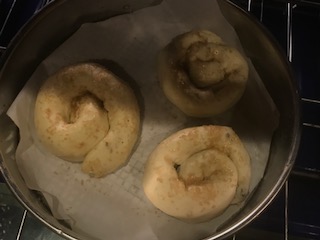 Do you have a lost family Christmas recipe you're longing to taste again? I finally perfected my mom's "Scarcello Christmas Pitta," a rich Southern Italian pastry coiled like a snake and filled with walnuts and raisins, flavored with whiskey, red pepper flakes and a trace of orange rind. It can also be served at Easter.
Do you have a lost family Christmas recipe you're longing to taste again? I finally perfected my mom's "Scarcello Christmas Pitta," a rich Southern Italian pastry coiled like a snake and filled with walnuts and raisins, flavored with whiskey, red pepper flakes and a trace of orange rind. It can also be served at Easter.My grandmother brought this recipe with her from Pedace, Italy, in Calabria. It's a speciality of the Sila, a beautiful forest in the hills above Pedace that I've visited several times with my Italian relatives. There it's called Pitta 'mpigliata. Pitta is from the Arabic and 'mpigliata from the Hebrew word for "crushed."
My Jewish husband loves this dish, which reminds him of his mother's apple strudel. Scholars trace it back to 1700 in San Giovanni in Fiore, practically next door to Pedace.
Mom and I made this raisin/nut delicacy during our last Christmas together, three years ago. She didn't really want to do it, but I begged her to, because it was my favorite. She was stressed and claimed that she couldn't remember how, but finally she rolled out the dough, lined up the filling, wound the dough over it, and then twisted it. She demanded that I do the same "because I'm not going to show you again." My rolls weren't as pretty as hers, but they tasted great, just as she had predicted.
"You make these things and sometimes they just don't turn out right," she said of all Italian pastries. "You just have to try again."
Mom created one big roll per buttered pan, by making three or four snakes and then coiling them around each other. I had better luck with three small ones. You can freeze the pitta; so you may as well make a bunch.
This dish is so simple that you almost don't need a recipe. What's tricky is the pastry. Every family has a different version. Mom left us two different recipes. I tried the first one this Christmas, three years after her death, and it flopped. It uses cooking oil. The dough was greasy and fell apart. I needed Mom to show me what went wrong. I'm not as skilled with adding flour as she was. Notice that the portions are gigantic. Families were big in those days.
Traditional crust
 6 eggs, beaten until foamy
6 eggs, beaten until foamy½ cup sugar
1 tsp salt
1/12 cups oil
Two cups milk
½ tsp baking powder
One or two tsp of whiskey or rum
Mix with about 10 cups flour and knead to smoothness
Optional crust
I was so happy when I tried this second crust, which rolled out beautifully. Mom called it "Suzanne B’s pie/pastry crust" and said, in a sweet way, "You may use it if you like."
I don't have a food processor, so I used a pastry cutter to get the butter and cream cheese mixed into the flour. Then I kneaded it by hand. It's a forgiving dough:
2 cubes butter
3 cups flour
8 oz. cream cheese
Process in food processor (or knead by hand) until smooth. Chill and roll thin.
Filling:
Mom used half chopped walnuts, half raisins in her filling, but I prefer a higher proportion of nuts. If you add the orange rind, go easy; otherwise, the orange flavor will overwhelm the dish. This filling worked for me:
Two cups chopped walnuts and one cup raisins with honey or Karo syrup (about 2 tablespoons). Mix together and sprinkle with water and red pepper flakes (scant) and orange rind (optional). Be sure to add a tablespoon or two of whiskey or rum, because the liquor gives the mix its distinctive flavor.
Technique:
 Roll the dough into thin strips (6” by 16-20” lengthwise), about ¼ inch thick. Spread the filling across the dough strips. Roll up and seal the sides. Twist like a curled snake in a buttered cake pan. You can coil the "snakes" around each other to make one big one (Mom's beautiful technique).
Roll the dough into thin strips (6” by 16-20” lengthwise), about ¼ inch thick. Spread the filling across the dough strips. Roll up and seal the sides. Twist like a curled snake in a buttered cake pan. You can coil the "snakes" around each other to make one big one (Mom's beautiful technique).Bake in a pie plate at 375 degrees until slightly brown. Check after 30-40 minutes. Do not overcook, but make sure you have a nice firm crust. Cool. Store in an airtight tin (not plastic). When ready to serve, slice into small slices, and serve with coffee or tea.
Here is a version made with figs, flavored with Grand Marnier, sliced in a similar way. We don't frost our pitta or add the sprinkles on top, but as Mom would say, "Do what you like."


